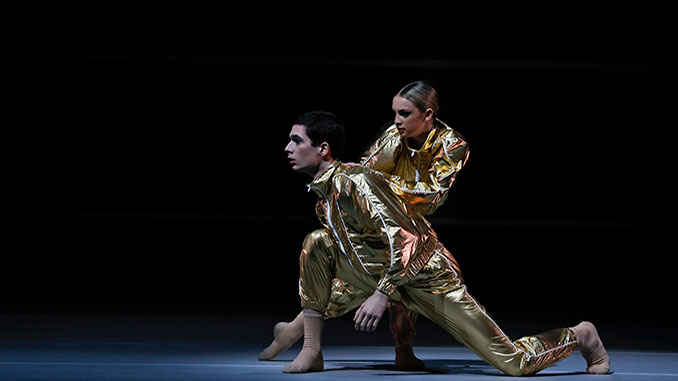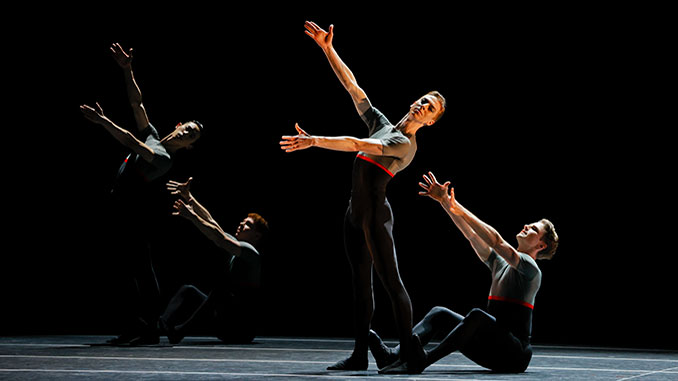 At Friday’s opening night on Melbourne’s State Theatre stage, not only evident was the intriguing variety and individuality contained within The Australian Ballet’s new triple bill, Instruments of Dance, but so too was the great organisational skill and combined company talent across the board to create what comes down to less than a couple of hours of pleasurable and thought-provoking dance.
At Friday’s opening night on Melbourne’s State Theatre stage, not only evident was the intriguing variety and individuality contained within The Australian Ballet’s new triple bill, Instruments of Dance, but so too was the great organisational skill and combined company talent across the board to create what comes down to less than a couple of hours of pleasurable and thought-provoking dance.
Artistic Director David Hallberg opened the evening with enthusiastic words, including his genuine acknowledgement of the Wurundjeri Woi Wurrung and Bunurong Boon Wurrung peoples who danced on these local lands for thousands of years prior – his palpable sensitivity and justified pride in the company reflected in three distinctive and captivating works.
First up of three resident choreographers from three of the world’s top ballet companies was Wayne McGregor from The Royal Ballet with his 2016 premiered work, Obsidian Tear. A new commission and world premiere performance from The Australian Ballet’s own Alice Topp followed with Annealing before concluding with the 2014 premiered work, Everywhere We Go, by New York City Ballet’s Justin Peck – all three works set to evocative contemporary scores.
 A work for 9 male dancers, Obsidian Tear begins in quietude as two bare-chested male dancers encounter each other – one in black flowing trousers (principal artist, Callum Linnane), the other in red (corps de ballet dancer, Adam Elmes).
A work for 9 male dancers, Obsidian Tear begins in quietude as two bare-chested male dancers encounter each other – one in black flowing trousers (principal artist, Callum Linnane), the other in red (corps de ballet dancer, Adam Elmes).
Then, a solo violin breaks the silence with masterful sounding eeriness by Sulki Yu – composer Esa-Pekka Salonen’s Lachen Verlernt.
A mix of attraction, curiosity, fear and aggression is quickly established on a minimalist setting of what could easily represent an expansive folded sheet of paper on an empty blackened stage with the sense of a narrative being written in dance appearing emphasised.
A third, authoritative figure in black tunic arrives (principal artist, Adam Bull) with a band of others as Salonen’s hugely atmospheric Nyx begins the second part. With the escalation of musical forces comes a frenzied and vicious picture of life being brutalised, toyed with and ultimately disposed of. Or perhaps sacrificed? Whatever the case, they being an outsider seems unquestionable.
McGregor feeds the mind with emotively compelling and kinetically-charged tableaux. Characterised by flexibly contorted movements, rhythmic angularity and intricate geometries, McGregor’s style depicts as much from a dancer’s energies within as he does from unseen external forces the dancer reacts to.
In that, McGregor had the brilliantly affecting soul and pliancy of Elmes’ ‘outsider’ in a standout performance, the ardency and complexity of Linnane’s ‘subject’ and the depth of conviction and power of Bull’s ‘leader’.
Surrounded by six passionate featured artists – Matthew Bradwell, Brett Chynoweth, Mason Lovegrove, Marcus Morelli, Christopher Rodgers-Wilson and Lucien Xu – the work feels rich in myth, tribalism and physicality.
Despite a conclusion in which the gravitating intensity is somewhat compromised after Elmes’ departing plunge – Linnane’s ‘subject’, in supposed grief or coercion, takes a death leap – Obsidian Tear is a vastly poignant and resonant encounter.
 From the hardness, brittleness and sharpness of Obsidian, Topp’s contrasting Annealing is an enchantingly choreographed and radiantly tempered work.
From the hardness, brittleness and sharpness of Obsidian, Topp’s contrasting Annealing is an enchantingly choreographed and radiantly tempered work.
Making reference to the process of heating metal to make it more malleable and ultimately stronger, the program notes state, “Topp’s conceptual framework for Annealing rewrites social and gender-based constructs around strength and softness, masculine and feminine, character and authentic self.”
In that respect, Topp’s work succeeds, generated by a blending of bodies and movements that develop into a sense of spiritual harmony.
Composer Bryony Marks’ specially commissioned score percolates with richness and appeal, opening with pizzicato strings as silvery costumed principal artists Amy Harris and Bull gradually meld with seductive fluidity, at times flamenco-like, in a beautiful pas de deux.
Corps de ballet dancer Samara Merrick and Elmes follow impressively, their glittering golden space-suit-like costumes creating a memorable molten pairing. A contingent of dancers in various golden costumes follow, creating orderly structured formations with brisk moves, sliding under set and lighting designer Jon Buswell’s effective translucent-panelled enclosure as they make entrances and exits.
Flowing on gracefully with principal artists Dimity Azoury and Linnane, the work gently comes to an end in calming, blue-lit darkness and feeling perfectly complete without outlasting its welcome. Peck’s delightful, upbeat and unabashedly plotless Everywhere We Go closes the triple bill in a hypnotising, breezy and precision-perfect fashion. That’s not to say it doesn’t conjure emotive responses which include a sense of hope and unity across its nine-movement, rapidly moving thirty-minute duration.
Peck’s delightful, upbeat and unabashedly plotless Everywhere We Go closes the triple bill in a hypnotising, breezy and precision-perfect fashion. That’s not to say it doesn’t conjure emotive responses which include a sense of hope and unity across its nine-movement, rapidly moving thirty-minute duration.
Indie singer-songwriter Sufjan Stevens’ score is often entertainingly suggestive of tele-series musical settings with a generous amount of percussive and brassy outbursts and circular, undulating undertones. To Stevens’ nod to minimalism, Broadway and jazz, Peck matches the score marvelously.
Classical ballet based with a sense of heavily caffeinated energy, movement and joy, a world of geometric and fractured dynamism takes hold as 25 dancers impart individual excellence amongst a body of both subtle humanity and inviting clockwork automation.
Charming body-fitting costumes by Janie Taylor – striped naval inspired costumes for females and two-toned 60s futuristic wear for males – give clarity to every bodily outline and unified move.
Ensemble highlights permeate the work as principal artists punctuate Karl Jensen’s set design consisting of little more than a geometrically patterned backdrop that keeps changing with the mood, assisted by chiaroscuro flair from lighting designer Brandon Stirling Baker.
Principal artists Benedicte Bemet and Brett Chynoweth make a particularly noteworthy pair who change the momentum with pinpoint focus as their combined plasticity and characterful presence emanates.
Complimenting the two earlier pieces, Everywhere We Go showcases dynamic body work, powerful physicality and expressive form from principals and corps de ballet alike.
Musically splendid in its depiction by Orchestra Victoria led by conductor Nicolette Fraillon and guest conductor Daniel Capps, Instruments of Dance is a rich smorgasbord of dance with a lot to take in and so much to take home.
Instruments of Dance
State Theatre – Arts Centre Melbourne, 100 St Kilda Road, Melbourne
Performance: Friday 23 September 2022
Season continues to 1 October 2022
Bookings: www.artscentremelbourne.com.au
For more information, visit: www.australianballet.com.au for details.
Images: Justin Peck’s Everywhere We Go featuring Artists of The Australian Ballet | Wayne McGregor’s Obsidian Tear featuring Callum Linnane and Adam Elmes | Alice Topp’s Annealing featuring Samara Merrick and Adam Elmes | Justin Peck’s Everywhere We Go featuring Artists of The Australian Ballet – all photos by Jeff Busby
Review: Paul Selar
